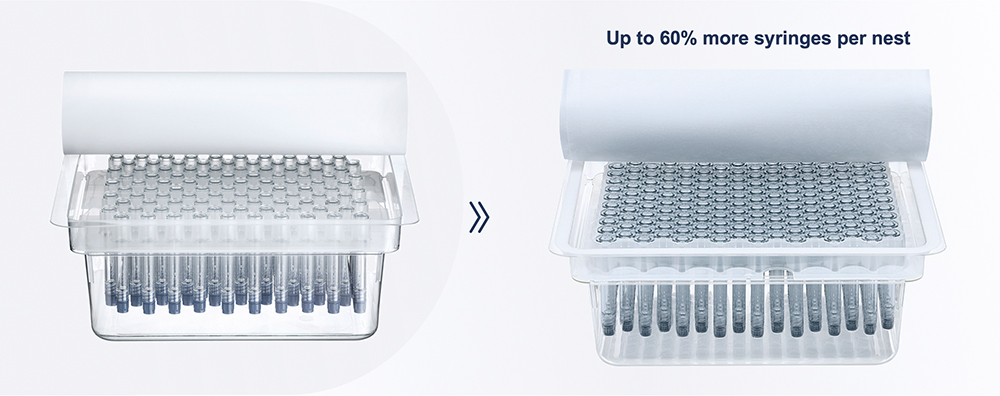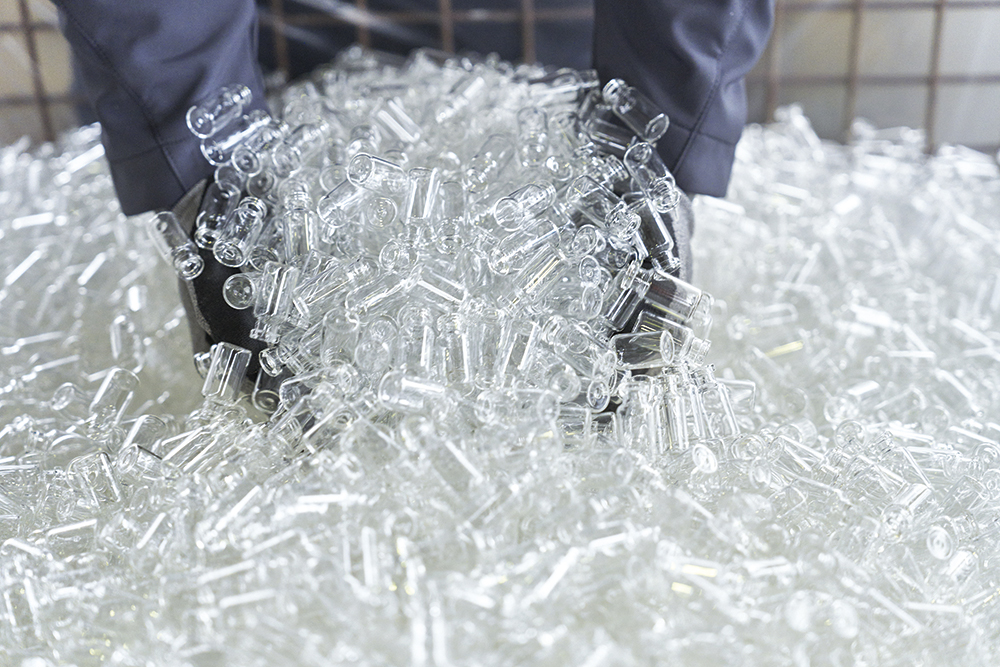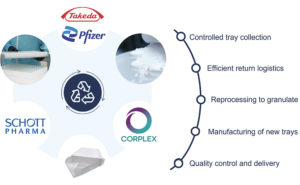To Issue 165
Citation: Ludihuser P, Kloke A, “Pioneering Pharmaceutical Packaging: a Push for Decarbonisation and Circularity”. ONdrugDelivery, Issue 165 (Sep/Oct 2024), pp 9–13.
Philipp Ludihuser and Arne Kloke highlight how SCHOTT Pharma’s collaboration with customers and partners in the pharmaceutical industry reduces the carbon emissions from the production of vials, cartridges, ampoules and syringes, as well as introducing circular solutions to increase resource efficiency.
The healthcare sector accounts for over 4% of global greenhouse gas (GHG) emissions. If the healthcare sector were a country, this volume of emissions would put it in fifth place in the global ranking.1 Another astonishing comparison: the pharmaceutical industry produced 48.55 tonnes of CO2 equivalents per million dollars of sales revenue in 2019, exceeding the automotive industry – commonly suspected of being the top emitter – by 55%. If the healthcare industry does not change its products, forecasts show that market growth would lead to a tripling of CO2 emissions by 2050.2
The good news is that the pharmaceutical industry has recognised the scale of the issue. Reducing carbon emissions, as well as avoiding waste and using resources more sustainably, are on the agenda of larger pharmaceutical companies.3 One important issue is primary pharmaceutical packaging – the container that is in direct contact with a drug. These containers are used in large quantities and, at the moment, the associated manufacturing processes rely on fossil fuels. An additional factor is that primary pharmaceutical packaging must be meticulously handled to meet the requirements of the pharmaceutical industry.
ON COURSE FOR DECARBONISATION AND A CIRCULAR ECONOMY
“To make primary pharmaceutical packaging more sustainable, SCHOTT Pharma is developing climate-neutral production methods and resource-efficient packaging solutions.”
To make primary pharmaceutical packaging more sustainable, SCHOTT Pharma is developing climate-neutral production methods and resource-efficient packaging solutions.
Decarbonisation
Together with the entire SCHOTT Group, SCHOTT Pharma is pursuing ambitious targets for reducing GHG emissions in the supply chain for primary pharmaceutical packaging. SCHOTT has aligned its climate targets with the current state of climate science. As part of this effort, the company has joined the global Science Based Targets initiative, a group whose members are pioneering strategies to decarbonise the economy. SCHOTT has committed to reducing its own Scope 1 and 2 GHG emissions by at least 46% by 2030 compared with 2019. In addition, the company aims to persuade its supply chain partners to reduce carbon emissions throughout the manufacturing process. In particular, SCHOTT and SCHOTT Pharma have set themselves the specific goal that, by 2027, 74% of Scope 3 emissions from goods and services purchased, capital goods and upstream transportation and distribution will be sourced from suppliers who themselves pursue science-based targets.
Resource-efficient Packaging
Together with suppliers and customers, SCHOTT Pharma is working on circular solutions for more efficient use of resources in pharmaceutical containers and their packaging. To this end, circular economy approaches will be established in the pharmaceutical industry while maintaining patient safety. Together with its partners, the company is examining current practices and paving the way to greater resource efficiency.
COLLABORATION
For both focus areas, collaboration is the decisive factor to successfully implement ambitious goals and concepts. SCHOTT Pharma regularly collaborates with selected pharmaceutical companies and suppliers on specific projects. This allows it to directly integrate the needs of the involved stakeholders into solution development. Jointly, SCHOTT Pharma and Pfizer presented this way of thinking and working at the Global Net Zero Supplier Summit organised by Pfizer to inspire more collaborative actions under the motto “Together, we can become change agents”.
Another approach that is driving the transformation towards net zero products is SCHOTT Pharma’s involvement in the Alliance to Zero. This cross-supply-chain initiative works across company boundaries to discover how the production of injection devices can be enhanced to bring them into line with the goals of the Paris Climate Agreement.
Since an industry cannot be transformed through small alliances alone, SCHOTT Pharma is actively committed to promoting serious technical discussion within the pharmaceutical industry. The company is not only the lead sponsor of the sustainability conferences at the Pharmapack and CPHI trade fairs in 2024 but is also co-organising the content (more information here). By selecting speakers from its own network and helping to shape the content, the joint project team – with the organiser Informa – aims to give participants a concrete understanding of the issues and provide inspiration on how transformation can succeed.
FOCUS 1: DECARBONISATION OF THE SUPPLY CHAIN FOR PHARMACEUTICAL PACKAGING
The vision of a decarbonised supply chain for pharmaceutical packaging is ambitious. To achieve it, SCHOTT Pharma is focusing on three fields of action that will reduce the emissions from its own manufacturing processes (Scope 1 and 2):
“The melting units are heated almost entirely with green electricity instead of natural gas to produce high-quality pharmaceutical tubular glass.”
- Since the end of 2021, 100% of the electricity requirements of all SCHOTT sites worldwide have been provided by green electricity. For this, a portfolio of Energy Attribute Certificates and power purchase agreements with regional coverage has been applied.
- Optimisation initiatives drive the continuous improvement of energy efficiency.
- When it comes to technological change in production, SCHOTT Pharma strives to avoid fossil fuels as much as possible. For example, emissions can be avoided by using electric furnaces in production, e.g. for stress relaxation of freshly formed primary packaging items, and by introducing electric glass-melting tanks at SCHOTT Tubing. Engineers are also evaluating ecologically sound alternatives for converting primary packaging materials.
From 2019 to the present day, SCHOTT Pharma has already reduced its Scope 1 and 2 emissions by 60%. It is now working closely with key suppliers to accelerate the reduction of Scope 3 emissions. This involves collaborating on sustainable packaging concepts and material solutions – and encouraging the use of green electricity. It also means that the sustainability performance of suppliers is assessed annually and integrated as a criterion in the supplier evaluation.
Significant Sources of Emissions for Primary Packaging
SCHOTT Pharma produces vials, cartridges, ampoules and syringes made of special glass. Taking the production of a 10 mL vial as an example, an emissions analysis with the base year 2019 shows the main sources of emissions (Figure 1). The state-of-the-art gas-based production of glass tubes is energy intensive, and its conversion into vials is responsible for the lion’s share of generated emissions. To make tubing, glass is melted in tanks heated to 1,600°C. Conversion of the tubular glass into primary packaging with the help of gas burners requires temperatures of up to 1,400°C. Transport and packaging have less of an impact in this example due to the high packing density.

Figure 1: Impact of green electricity and electrified melting on emissions of a 10 mL vial along the supply chain.
By switching to 100% green electricity in 2021 and implementing energy efficiency measures, SCHOTT Pharma has already reduced its CO2 emissions per vial by 30% compared with 2019, especially in the highly automated converting process. The next step – to produce glass tubing in electrified tanks at SCHOTT Tubing – is expected to further reduce emissions to a projected total of 50% compared with 2019. This represents a profound technological change and requires pharmaceutical customers to embrace change. The technology will be realised for the first time in a new tank producing FIOLAX® Pro by 2026. SCHOTT Tubing and SCHOTT Pharma are aiming to set a new standard for the entire glass industry.
Green Electricity Instead of Natural Gas in the Glass-Melting Tank
In recent years, SCHOTT experts have developed a new electric-driven melting process. In this process, the melting units are heated almost entirely with green electricity instead of natural gas to produce high-quality pharmaceutical tubular glass.
The new electric tank will be set up and validated at the SCHOTT Tubing site in Mitterteich, Germany by 2026, producing the next-generation pharmaceutical Type I glass FIOLAX® Pro. Around €40 million (£34 million) will be invested in the project, including around €15 million in subsidies. According to initial calculations, CO2 emissions in glass melting are expected to be 80% lower than a comparable tank powered by gas. The combination of an electric tank and 100% green electricity is projected to reduce emissions per glass vial by around 50% compared with 2019.
The next step is to collaborate with pharmaceutical customers and integrate primary packaging made from electrically melted FIOLAX® Pro glass into their products and regulatory documentation. SCHOTT and SCHOTT Pharma are developing further solutions to continuously reduce emissions from raw materials, transportation, post-processing, converting and packaging.
Higher Packing Density Means Fewer Scope 3 Emissions
For pre-sterilised products, more complex packaging with a significantly lower packing density is used than for the non-sterilised products discussed above. As a result, the percentage share of packaging in a product’s carbon footprint can be similar to that of the actual pharmaceutical container.
SCHOTT Pharma’s internal eco-design guidelines therefore strive for the development of concepts to maximise packing density. For example, if 160 syringes instead of 100 can be packed in one unit, about 38% less packaging material is required (Figure 2). This results in significantly less waste for the processing customer, as well as lower Scope 3 emissions for the production of the packaging. It also enables customers to achieve more compact handling, from transportation and storage through to processing on the filling lines.

Figure 2: Optimised packaging for pre-sterilised polymer syringes.
Even though these measures are a win-win situation for those involved and the environment, it will require adaptation for the filling process, however, SCHOTT Pharma has already gained like-minded customers at an early stage.
FOCUS 2: RESOURCE-EFFICIENT PACKAGING
The second major aspect of sustainability is to establish closed loops in the pharmaceutical industry. This means working with customers and suppliers on reducing the need for new raw materials, reducing CO2 emissions and finding ways to handle waste more responsibly. This applies to both glass and plastic packaging. SCHOTT Pharma also aims to ensure that materials that have been passed on can be returned to the cycle. To this end, the internal eco-design guideline specifies what needs to be considered during product development.
Reintroducing Glass – Saving Energy, Raw Materials and Emissions
In the production of glass-based primary packaging items, a certain share of the incoming glass tube volumes, such as the tube ends, cannot be converted to marketable goods. Those glass volumes are returned as glass cullets to the nearest tubing plant and are used in the production of new glass. This long-established practice conserves resources and avoids waste. It also reduces energy consumption and emissions, since cullets melt at a lower temperature than the raw materials, which accelerates the melting process.
If the return to tubing production is not reasonable due to long transport routes, the glass cullets can be applied locally for other purposes – as filling material for civil engineering and road construction projects, in cement production or as a component of glass fibre insulation and glass wool, for example.
Returning pharmaceutical glass vials from pharmaceutical companies is not yet common practice. A first step in this direction was achieved by a pioneering pilot project with Sanofi. Here, SCHOTT Tubing took back unused glass vials, processed them into cullets and turned them back into high-quality pharmaceutical glass tubing (Figure 3).

Figure 3: Glass vials for turning back into high-quality pharmaceutical glass tubing.
The condition for this success and the creation of a truly closed cycle was the verifiable purity of the glass used. The vials were made exclusively from FIOLAX® clear glass. Otherwise, the quality and purity of the end products required in the highly sensitive pharmaceutical industry could not be guaranteed. The reversed supply chain was particularly challenging since the actual end customer became the raw material supplier for the glass melt. The experience gained through this project is a valuable first step on the way to a more circular material flow.
Pilot Project for Recycling Packaging
Today, the pharmaceutical industry uses intermediate packaging for the shipment of primary packaging. The intermediate packaging is made of virgin materials to avoid the risk of contamination. After a single use, intermediate packaging items end up directly in the waste. Over the course of a year, several tonnes of the corresponding plastics, clean and originally sorted, accumulate at pharmaceutical companies. These plastics are mixed with plastic waste from other companies via the usual disposal channels. As a result, the collected materials can no longer be reprocessed for use in comparable applications.

Figure 4: Closing the loop for intermediate packaging in the pharma supply chain.
In a joint project, SCHOTT Pharma and packaging manufacturer Corplex (Colmar, France) are working on solutions to increase resource efficiency with the pharmaceutical companies Pfizer and Takeda, respectively. In particular, the collaboration focuses on the development, testing and evaluation of a closedloop system for polypropylene trays (Figure 4). These polypropylene trays are widely used in the pharma industry for the shipping and storing of non-sterile primary packaging. To recycle these trays in a pharma-compliant way, there are a few challenges to resolve:
- How to ensure the quality of used materials as a basis for new trays?
- How to prevent contamination of the material by foreign substances?
- How to avoid the degeneration of recycled material?
- How to achieve acceptance within the pharmaceutical industry?
Against this background, the partners are testing collection and logistics concepts that combine efficient operation with a clean and separate material flow. Detailed testing is also carried out to investigate the impact of reprocessing on mechanical and chemical material properties. These tests aim to confirm that the use of closed-loop recycled content adds no risk to the drug product.
“Closed-loop recycling makes it possible to reduce the emissions from each tray produced and the need for virgin raw materials.”
Closed-loop recycling makes it possible to reduce the emissions from each tray produced and the need for virgin raw materials. It also ensures that the pharmaceutical manufacturer’s waste becomes a high-quality raw material, available for further processing. The results of this collaboration and a tonne-scale pilot project will be announced later this year.
CONCLUSION
Climate change poses an enormous threat to the environment, and the pharmaceutical industry has a significant role to play. SCHOTT Pharma intends to meet its responsibilities and lead the way. It is committed to the social and sustainable values adopted by the Carl Zeiss Foundation since its foundation in 1889 and of its parent company, SCHOTT. In this sense, innovation, pioneering spirit and, above all, co-operation along the value chain within the pharmaceutical industry are essential to bring about all necessary changes.
On the path to sustainable pharmaceutical packaging solutions, SCHOTT’s current focus is on decarbonisation and resource efficiency, including the introduction of circular economy principles into the pharmaceutical industry. SCHOTT Pharma sees itself as a committed player and visionary that questions existing practices and, together with customers and other partners in the value chain, implements solutions that minimise environmental impact without compromising patient safety.
Arne Kloke will be hosting the Sustainable Futures Conference within CPHI 2024 in Milan as Chairman. For more information click here.
REFERENCES
- “Healthcare’s climate footprint”. Web Page, ARUP, Sep 2019.
- “Six ways the pharmaceutical industry can reduce its climate impact”. Web Page, World Economic Forum, Nov 25, 2022.
- Annual Report 2023, Pharmaceutical Supply Chain Initiative.

